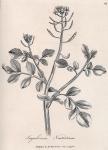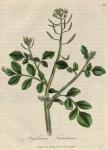
 Synonyma. Nasturtium aquaticum. Pharm. Lond. & Edinb.
Synonyma. Nasturtium aquaticum. Pharm. Lond. & Edinb.
Nasturtium aquaticum supinum. Bauh. Pin. p. 105.
Nasturtium aquaticum, sive Cratevae Sium. Gerard. Emac. p. 257.
Sisymbrium Cardamine sive N. aquaticum. J. Bauh. Hist. vol. 2. p. 884.
Nasturtium aquaticum vulgare. Raii. Hist. 816. Synop. p. 300. Park. Theat. p. 1239.
Sisymbrium foliis pinnatis, pinnis subrotundis, brevibus racemis. Hal. Stirp. Helv. n. 482.
Sisymbrium Nasturtium. Withering. Bot. Arrang. p. 690. Flor. Dan. t. 690. Curt. Flor. Lond.
(greek) s. (greek) Dioscorid.
Class Tetradynamia. Ord. Siliquosa. Lin. Gen. Plant. 813.
Ess. Gen. Ch. Siliqua dehiscens valvulis rectiusculis. Calyx patens. Corolla patens.
Spec. Char. S. siliquis declinatis, foliis pinnatis: foliolis subcordatis.
The root is biennial, long, creeping, and beset with several close tufts of long slender fibres: the stalks are thick, branched, and frequently rise above a foot high: the leaves are pinnated, and consist of two or three pair of irregular oblong pinnae, and terminated by an odd one, which is the largest: the flowers are disposed in short terminal spikes, and appear in June and July: the corolla consists of four petals, which at their extremities are roundish, spreading, and of a white colour: the calyx is of four oval leafits, which commonly fall off by the expansion of the flower: the stamina are six, four long and two short, and furnished with simple antherae: the style is short, with an obtuse stigma: the germen is long, slender, and becomes a crooked pod, which contains small round seeds. It is a native of Britain, and grows commonly in brooks and stagnant waters.
"The leaves of the Water-cresses have a moderately pungent taste, emit a quick penetrating smell, like that of mustard-feed, but much weaker. Their pungent matter is taken up both by watery and spirituous menstrua, and accompanies the aqueous juice, which issues copiously upon expreflion: it is very volatile so as to arise, [This volatile matter has been erroneously attributed to an alkaline or alkalescent quality of the plant.] in great part, in distillation, with rectified spirit, as well as with water, and almost totally to exhale in drying the leaves, or inspissating by the gentlest heat to the consistence of an extract, either the expressed juice, or the watery or spirituous tinctures. Both the inspissated juice, and the watery extract, discover to the taste a saline impregnation, and in keeping throw up crystalline efflorescences to the surface. On distilling considerable quantities of the herb with water, a small proportion of a subtile volatile very pungent oil is obtained." [Lewis Mat. Med.]
Water-cresses obtain a place in the Materia Medica for their antiscorbutic qualities, which have been long very generally acknowledged by physicians. They are also supposed to purify the blood and humours, and to open visceral obstructions; [Hoffman and Haller thought highly of its powers in this way.] they are nearly allied to scurvy-grass, but are more mild and pleasant, and for this reason are frequently eaten as sallad. In the pharmacopoeias the juice of this plant is directed with that of scurvy-grass and Seville oranges; and Dr. Cullen has remarked, that the addition of acids renders the juices of the plantae siliquosae more certainly effectual, by determining them more powerfully to an acescent fermentation." [Mat. Med.]

